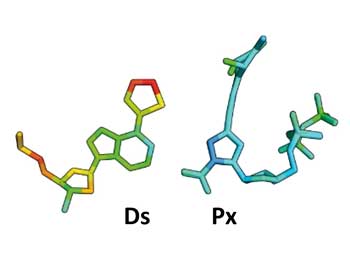Just like how alphabets are strung together to form words, our DNA is also strung together by alphabets to encode proteins. Our DNA contains only 4 natural genetic alphabets - A, C, G and T, which hold the blueprint for the production of proteins that make our bodies work.
Now, researchers from the Institute of Bioengineering and Nanotechnology (IBN) of the Agency for Science, Technology and Research (A*STAR) have created a DNA technology with two new genetic alphabets that could better detect infectious diseases, such as dengue and Zika (Angewandte Chemie International Edition, "Structural Basis for Expansion of the Genetic Alphabet by an Artificial Base Pair").

Genetic alphabet expansion technology is the introduction of artificial base pairs into DNA. The existing four genetic alphabets are naturally bound together in base pairs of A-T and G-C. These specific base pair formations are essential in DNA replication, which occurs in all living organisms. It is the process by which a DNA molecule is duplicated to produce two identical molecules.
“The expansion of the genetic alphabet is a significant scientific achievement. It sheds insights into DNA’s natural replication mechanism, which will help us to design unique DNA molecules and technologies. For example, our technology can be used to create novel diagnostics and therapeutic agents with superior efficacy,” said IBN Executive Director Professor Jackie Y. Ying.
In 2009, IBN Team Leader and Principal Research Scientist Dr Ichiro Hirao and IBN Senior Research Scientist Dr Michiko Kimoto created two new genetic alphabets – Ds and Px, which specifically combine with each other to form an artificial base pair that could function as a third DNA base pair. However, the molecular structure of the new base pair had never been determined until they collaborated recently with Professor Andrea Marx from the University of Konstanz in Germany on the structural analysis of their new base pair.
Using X-ray crystallography, the researchers uncovered the 3D molecular structure of the Ds-Px base pair during DNA replication by analyzing the X-ray diffraction through a crystal. They found that the structure of the new artificial base pair was strikingly similar to a natural base pair.
Dr Hirao said, “The inspiration for the design of our new DNA base pair came from jigsaw puzzles, where complementary shapes fit together to form the specific pair. However, our concept had only been a hypothesis until now. We did not know the actual molecular structure of our Ds-Px pair during DNA replication until the recent study with our collaborators at University of Konstanz. They confirmed that we are heading in the right direction, which would allow us to create biological components that can enhance DNA’s natural functions.”
Using this genetic alphabet expansion technology, IBN is developing DNA aptamers, which are modified DNA molecules that can bind to molecular targets in the body. The team plans to launch a test kit using these DNA aptamers to detect infectious diseases, such as dengue and Zika, in the next two years.
Source: A*STAR
Read More:https://www.nanowerk.com/news2/biotech/newsid=48415.php
Copyright © 2024 International Society of Bionic Engineering All Rights Reserved
吉ICP备11002416号-1









